Comparative Analysis: G2000 and Bossini's Organizational Structures
VerifiedAdded on 2020/01/07
|20
|6511
|200
Report
AI Summary
This report provides a comprehensive analysis of the organizational structures, leadership styles, and motivational theories employed by G2000 and Bossini, two prominent retail clothing brands. The report delves into the comparison of different organizational structures, including flat and functional models, and examines how organizational culture influences individual behavior and business performance. It explores various leadership styles, such as participative and transformational approaches, and assesses their impact on employee motivation and team effectiveness. Furthermore, the report investigates the factors that promote or hinder team development and the influence of technology on team functioning. By comparing and contrasting the practices of G2000 and Bossini, the report offers valuable insights into the relationship between organizational design, leadership, and employee performance.
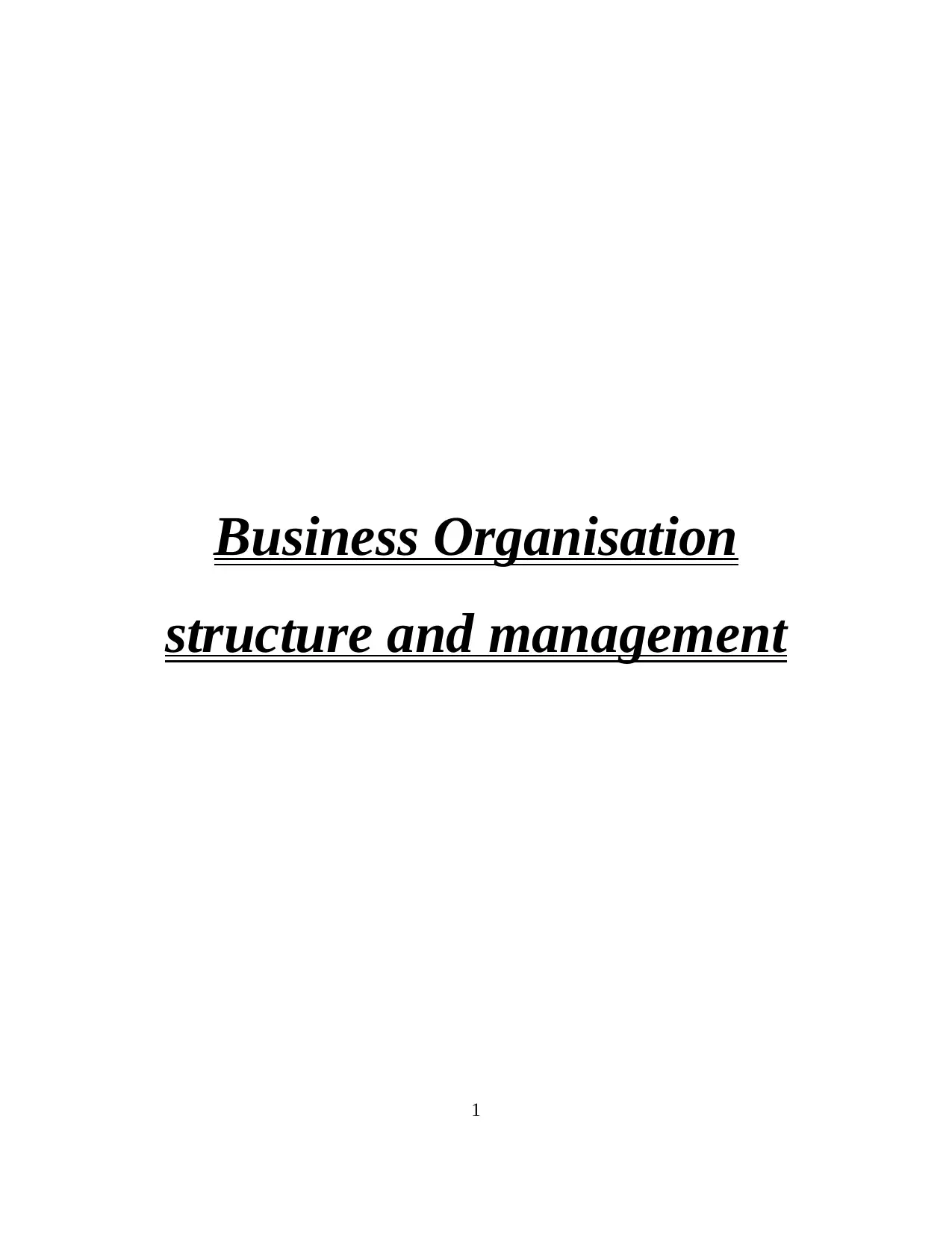
Business Organisation
structure and management
1
structure and management
1
Paraphrase This Document
Need a fresh take? Get an instant paraphrase of this document with our AI Paraphraser
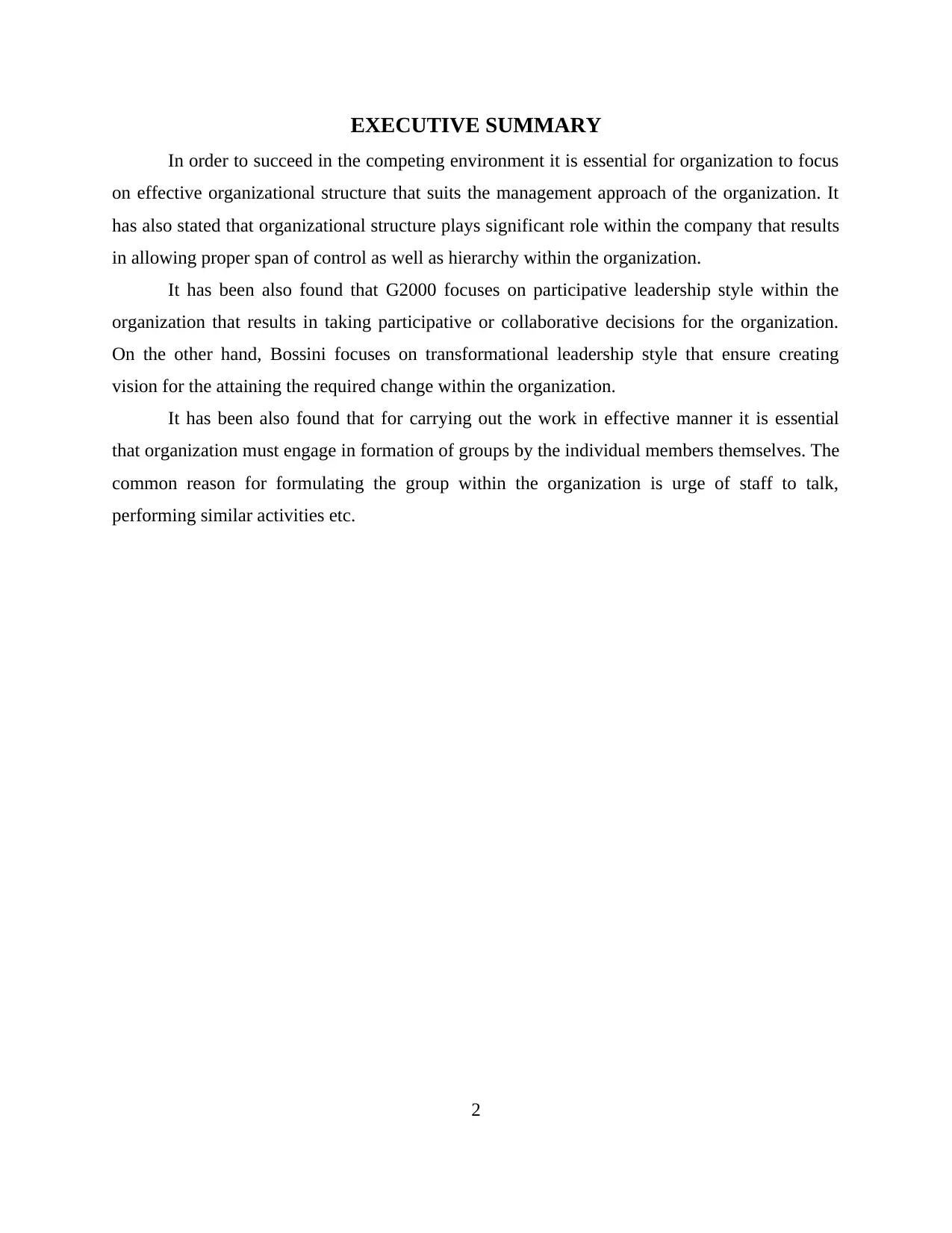
EXECUTIVE SUMMARY
In order to succeed in the competing environment it is essential for organization to focus
on effective organizational structure that suits the management approach of the organization. It
has also stated that organizational structure plays significant role within the company that results
in allowing proper span of control as well as hierarchy within the organization.
It has been also found that G2000 focuses on participative leadership style within the
organization that results in taking participative or collaborative decisions for the organization.
On the other hand, Bossini focuses on transformational leadership style that ensure creating
vision for the attaining the required change within the organization.
It has been also found that for carrying out the work in effective manner it is essential
that organization must engage in formation of groups by the individual members themselves. The
common reason for formulating the group within the organization is urge of staff to talk,
performing similar activities etc.
2
In order to succeed in the competing environment it is essential for organization to focus
on effective organizational structure that suits the management approach of the organization. It
has also stated that organizational structure plays significant role within the company that results
in allowing proper span of control as well as hierarchy within the organization.
It has been also found that G2000 focuses on participative leadership style within the
organization that results in taking participative or collaborative decisions for the organization.
On the other hand, Bossini focuses on transformational leadership style that ensure creating
vision for the attaining the required change within the organization.
It has been also found that for carrying out the work in effective manner it is essential
that organization must engage in formation of groups by the individual members themselves. The
common reason for formulating the group within the organization is urge of staff to talk,
performing similar activities etc.
2
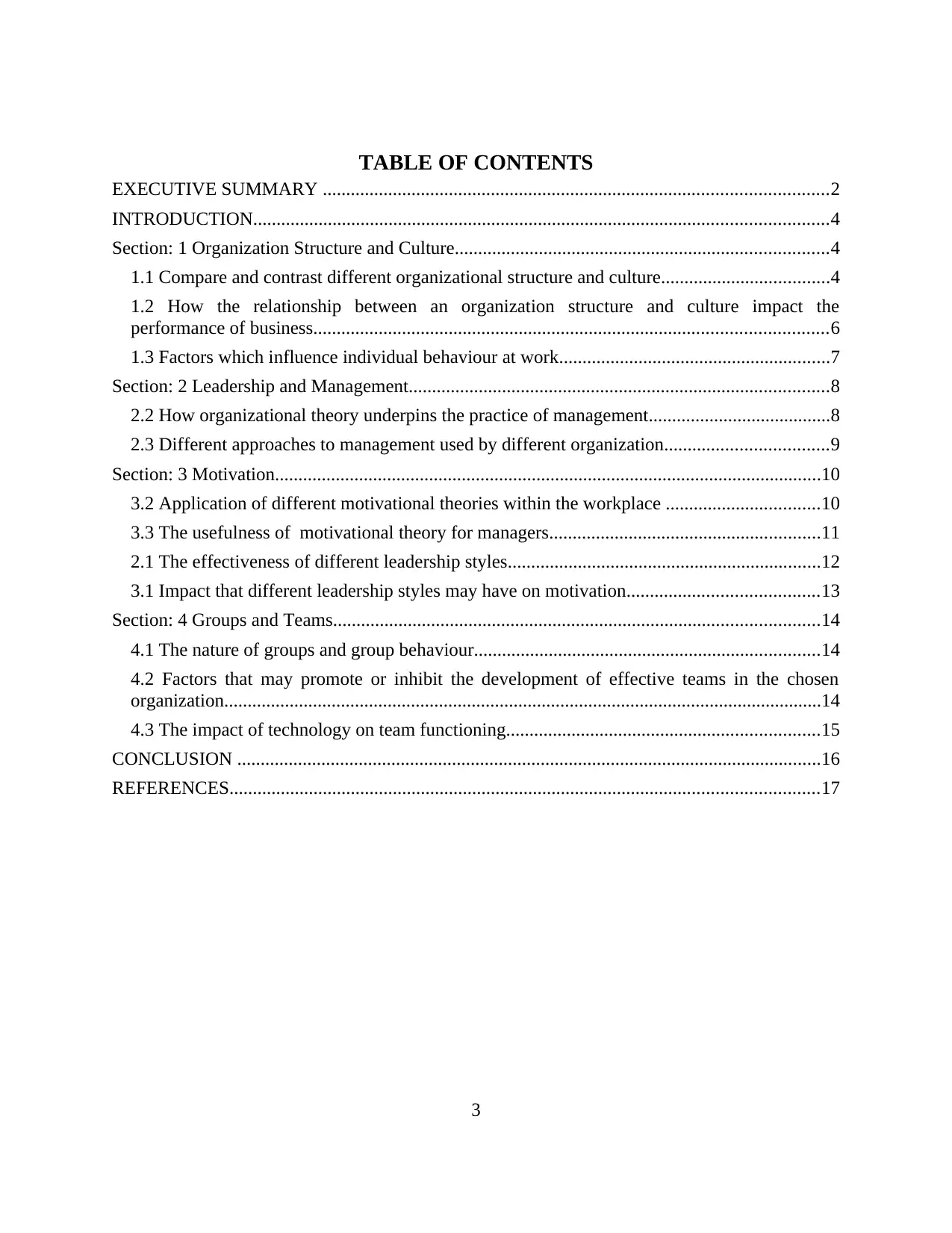
TABLE OF CONTENTS
EXECUTIVE SUMMARY ............................................................................................................2
INTRODUCTION...........................................................................................................................4
Section: 1 Organization Structure and Culture................................................................................4
1.1 Compare and contrast different organizational structure and culture....................................4
1.2 How the relationship between an organization structure and culture impact the
performance of business..............................................................................................................6
1.3 Factors which influence individual behaviour at work..........................................................7
Section: 2 Leadership and Management..........................................................................................8
2.2 How organizational theory underpins the practice of management.......................................8
2.3 Different approaches to management used by different organization...................................9
Section: 3 Motivation.....................................................................................................................10
3.2 Application of different motivational theories within the workplace .................................10
3.3 The usefulness of motivational theory for managers..........................................................11
2.1 The effectiveness of different leadership styles...................................................................12
3.1 Impact that different leadership styles may have on motivation.........................................13
Section: 4 Groups and Teams........................................................................................................14
4.1 The nature of groups and group behaviour..........................................................................14
4.2 Factors that may promote or inhibit the development of effective teams in the chosen
organization................................................................................................................................14
4.3 The impact of technology on team functioning...................................................................15
CONCLUSION .............................................................................................................................16
REFERENCES..............................................................................................................................17
3
EXECUTIVE SUMMARY ............................................................................................................2
INTRODUCTION...........................................................................................................................4
Section: 1 Organization Structure and Culture................................................................................4
1.1 Compare and contrast different organizational structure and culture....................................4
1.2 How the relationship between an organization structure and culture impact the
performance of business..............................................................................................................6
1.3 Factors which influence individual behaviour at work..........................................................7
Section: 2 Leadership and Management..........................................................................................8
2.2 How organizational theory underpins the practice of management.......................................8
2.3 Different approaches to management used by different organization...................................9
Section: 3 Motivation.....................................................................................................................10
3.2 Application of different motivational theories within the workplace .................................10
3.3 The usefulness of motivational theory for managers..........................................................11
2.1 The effectiveness of different leadership styles...................................................................12
3.1 Impact that different leadership styles may have on motivation.........................................13
Section: 4 Groups and Teams........................................................................................................14
4.1 The nature of groups and group behaviour..........................................................................14
4.2 Factors that may promote or inhibit the development of effective teams in the chosen
organization................................................................................................................................14
4.3 The impact of technology on team functioning...................................................................15
CONCLUSION .............................................................................................................................16
REFERENCES..............................................................................................................................17
3
⊘ This is a preview!⊘
Do you want full access?
Subscribe today to unlock all pages.

Trusted by 1+ million students worldwide
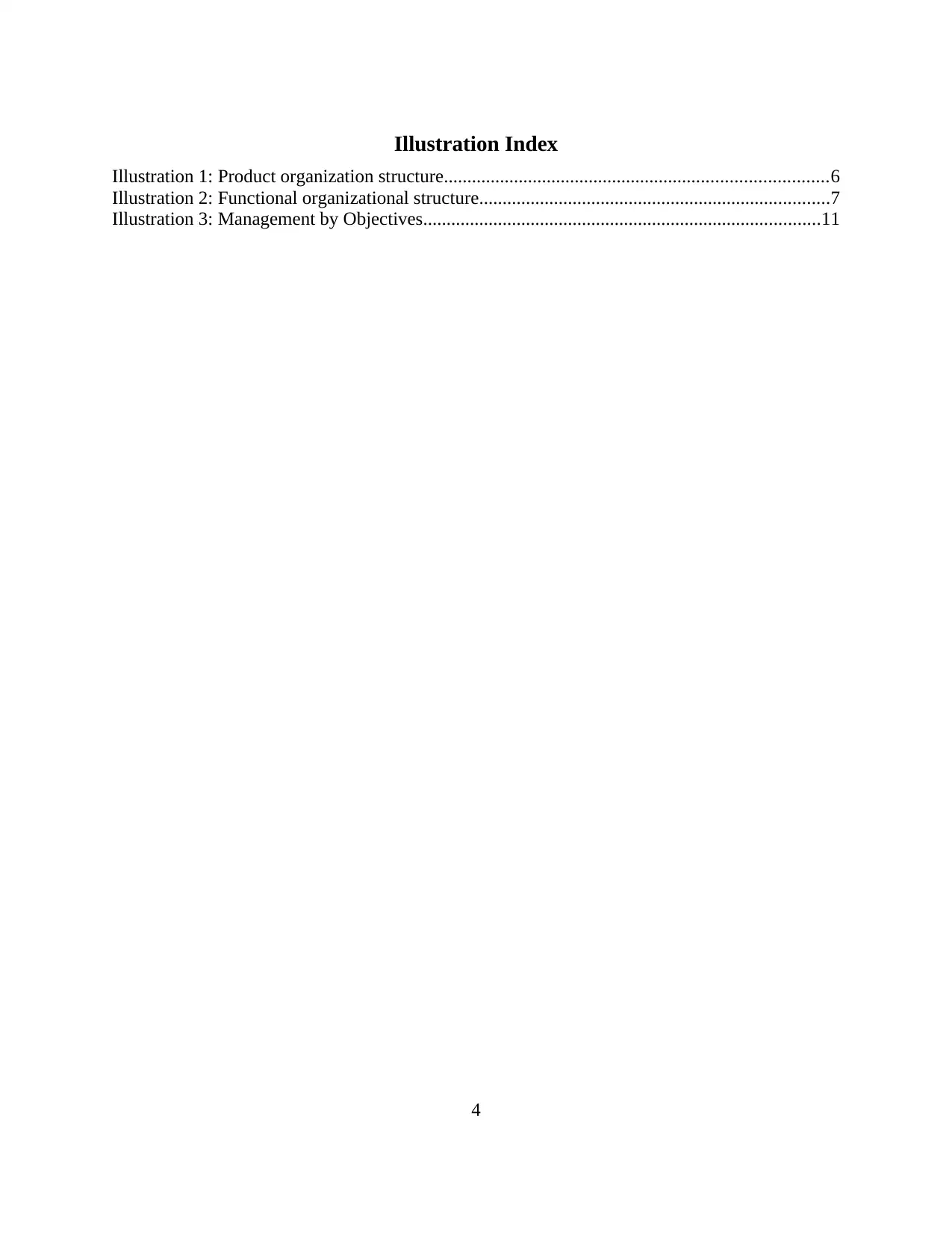
Illustration Index
Illustration 1: Product organization structure..................................................................................6
Illustration 2: Functional organizational structure...........................................................................7
Illustration 3: Management by Objectives.....................................................................................11
4
Illustration 1: Product organization structure..................................................................................6
Illustration 2: Functional organizational structure...........................................................................7
Illustration 3: Management by Objectives.....................................................................................11
4
Paraphrase This Document
Need a fresh take? Get an instant paraphrase of this document with our AI Paraphraser
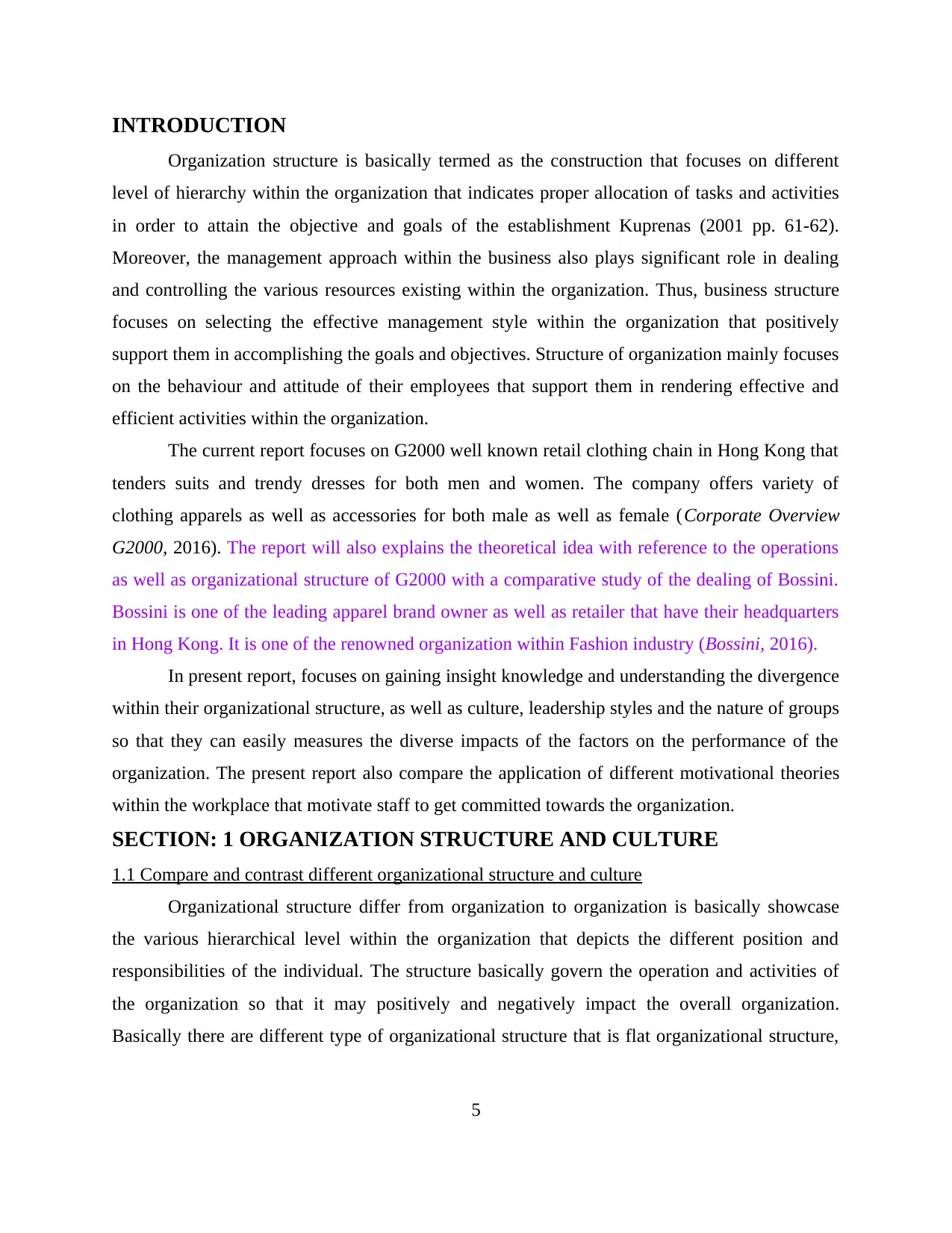
INTRODUCTION
Organization structure is basically termed as the construction that focuses on different
level of hierarchy within the organization that indicates proper allocation of tasks and activities
in order to attain the objective and goals of the establishment Kuprenas (2001 pp. 61-62).
Moreover, the management approach within the business also plays significant role in dealing
and controlling the various resources existing within the organization. Thus, business structure
focuses on selecting the effective management style within the organization that positively
support them in accomplishing the goals and objectives. Structure of organization mainly focuses
on the behaviour and attitude of their employees that support them in rendering effective and
efficient activities within the organization.
The current report focuses on G2000 well known retail clothing chain in Hong Kong that
tenders suits and trendy dresses for both men and women. The company offers variety of
clothing apparels as well as accessories for both male as well as female (Corporate Overview
G2000, 2016). The report will also explains the theoretical idea with reference to the operations
as well as organizational structure of G2000 with a comparative study of the dealing of Bossini.
Bossini is one of the leading apparel brand owner as well as retailer that have their headquarters
in Hong Kong. It is one of the renowned organization within Fashion industry (Bossini, 2016).
In present report, focuses on gaining insight knowledge and understanding the divergence
within their organizational structure, as well as culture, leadership styles and the nature of groups
so that they can easily measures the diverse impacts of the factors on the performance of the
organization. The present report also compare the application of different motivational theories
within the workplace that motivate staff to get committed towards the organization.
SECTION: 1 ORGANIZATION STRUCTURE AND CULTURE
1.1 Compare and contrast different organizational structure and culture
Organizational structure differ from organization to organization is basically showcase
the various hierarchical level within the organization that depicts the different position and
responsibilities of the individual. The structure basically govern the operation and activities of
the organization so that it may positively and negatively impact the overall organization.
Basically there are different type of organizational structure that is flat organizational structure,
5
Organization structure is basically termed as the construction that focuses on different
level of hierarchy within the organization that indicates proper allocation of tasks and activities
in order to attain the objective and goals of the establishment Kuprenas (2001 pp. 61-62).
Moreover, the management approach within the business also plays significant role in dealing
and controlling the various resources existing within the organization. Thus, business structure
focuses on selecting the effective management style within the organization that positively
support them in accomplishing the goals and objectives. Structure of organization mainly focuses
on the behaviour and attitude of their employees that support them in rendering effective and
efficient activities within the organization.
The current report focuses on G2000 well known retail clothing chain in Hong Kong that
tenders suits and trendy dresses for both men and women. The company offers variety of
clothing apparels as well as accessories for both male as well as female (Corporate Overview
G2000, 2016). The report will also explains the theoretical idea with reference to the operations
as well as organizational structure of G2000 with a comparative study of the dealing of Bossini.
Bossini is one of the leading apparel brand owner as well as retailer that have their headquarters
in Hong Kong. It is one of the renowned organization within Fashion industry (Bossini, 2016).
In present report, focuses on gaining insight knowledge and understanding the divergence
within their organizational structure, as well as culture, leadership styles and the nature of groups
so that they can easily measures the diverse impacts of the factors on the performance of the
organization. The present report also compare the application of different motivational theories
within the workplace that motivate staff to get committed towards the organization.
SECTION: 1 ORGANIZATION STRUCTURE AND CULTURE
1.1 Compare and contrast different organizational structure and culture
Organizational structure differ from organization to organization is basically showcase
the various hierarchical level within the organization that depicts the different position and
responsibilities of the individual. The structure basically govern the operation and activities of
the organization so that it may positively and negatively impact the overall organization.
Basically there are different type of organizational structure that is flat organizational structure,
5
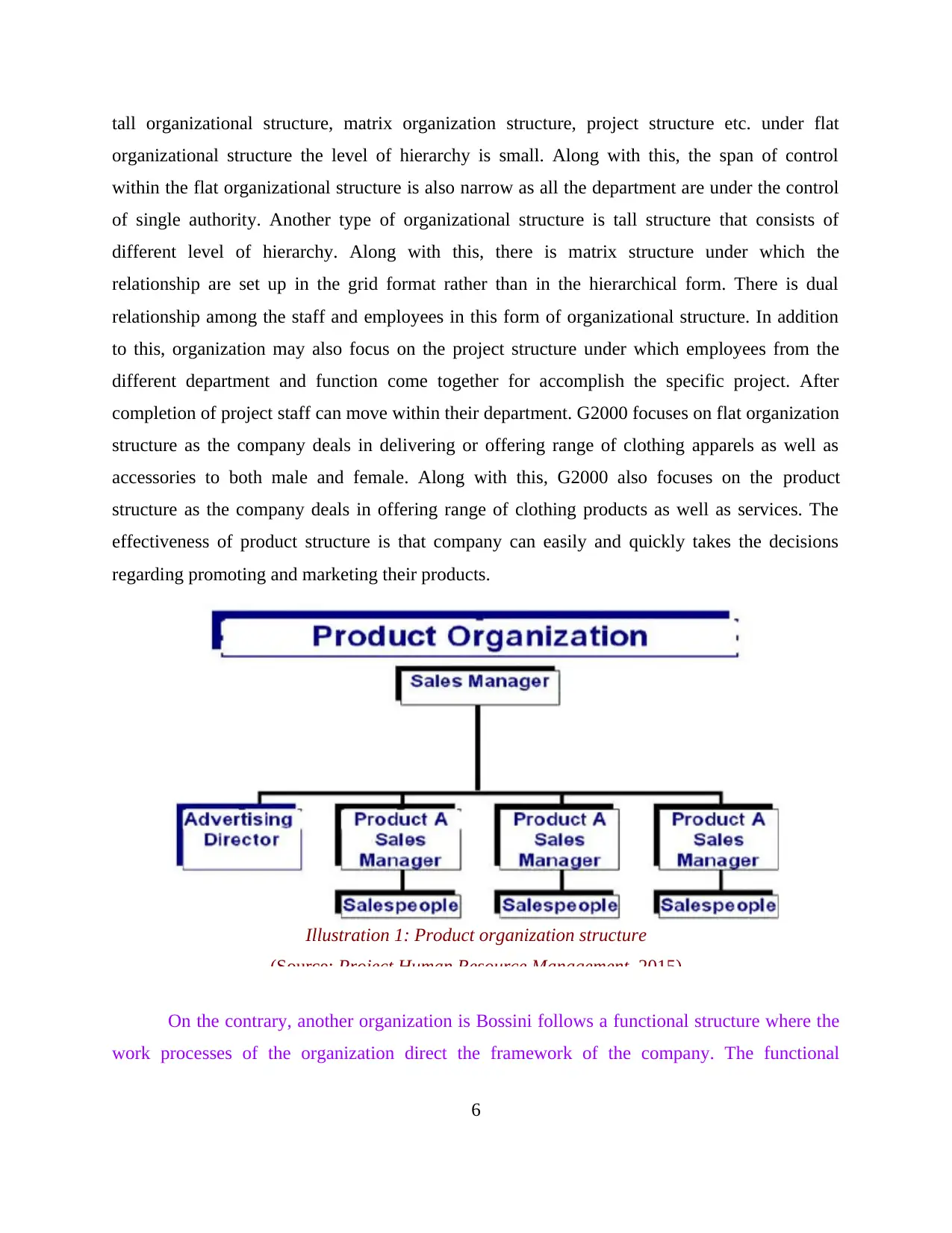
tall organizational structure, matrix organization structure, project structure etc. under flat
organizational structure the level of hierarchy is small. Along with this, the span of control
within the flat organizational structure is also narrow as all the department are under the control
of single authority. Another type of organizational structure is tall structure that consists of
different level of hierarchy. Along with this, there is matrix structure under which the
relationship are set up in the grid format rather than in the hierarchical form. There is dual
relationship among the staff and employees in this form of organizational structure. In addition
to this, organization may also focus on the project structure under which employees from the
different department and function come together for accomplish the specific project. After
completion of project staff can move within their department. G2000 focuses on flat organization
structure as the company deals in delivering or offering range of clothing apparels as well as
accessories to both male and female. Along with this, G2000 also focuses on the product
structure as the company deals in offering range of clothing products as well as services. The
effectiveness of product structure is that company can easily and quickly takes the decisions
regarding promoting and marketing their products.
Illustration 1: Product organization structure
(Source: Project Human Resource Management, 2015)
On the contrary, another organization is Bossini follows a functional structure where the
work processes of the organization direct the framework of the company. The functional
6
organizational structure the level of hierarchy is small. Along with this, the span of control
within the flat organizational structure is also narrow as all the department are under the control
of single authority. Another type of organizational structure is tall structure that consists of
different level of hierarchy. Along with this, there is matrix structure under which the
relationship are set up in the grid format rather than in the hierarchical form. There is dual
relationship among the staff and employees in this form of organizational structure. In addition
to this, organization may also focus on the project structure under which employees from the
different department and function come together for accomplish the specific project. After
completion of project staff can move within their department. G2000 focuses on flat organization
structure as the company deals in delivering or offering range of clothing apparels as well as
accessories to both male and female. Along with this, G2000 also focuses on the product
structure as the company deals in offering range of clothing products as well as services. The
effectiveness of product structure is that company can easily and quickly takes the decisions
regarding promoting and marketing their products.
Illustration 1: Product organization structure
(Source: Project Human Resource Management, 2015)
On the contrary, another organization is Bossini follows a functional structure where the
work processes of the organization direct the framework of the company. The functional
6
⊘ This is a preview!⊘
Do you want full access?
Subscribe today to unlock all pages.

Trusted by 1+ million students worldwide
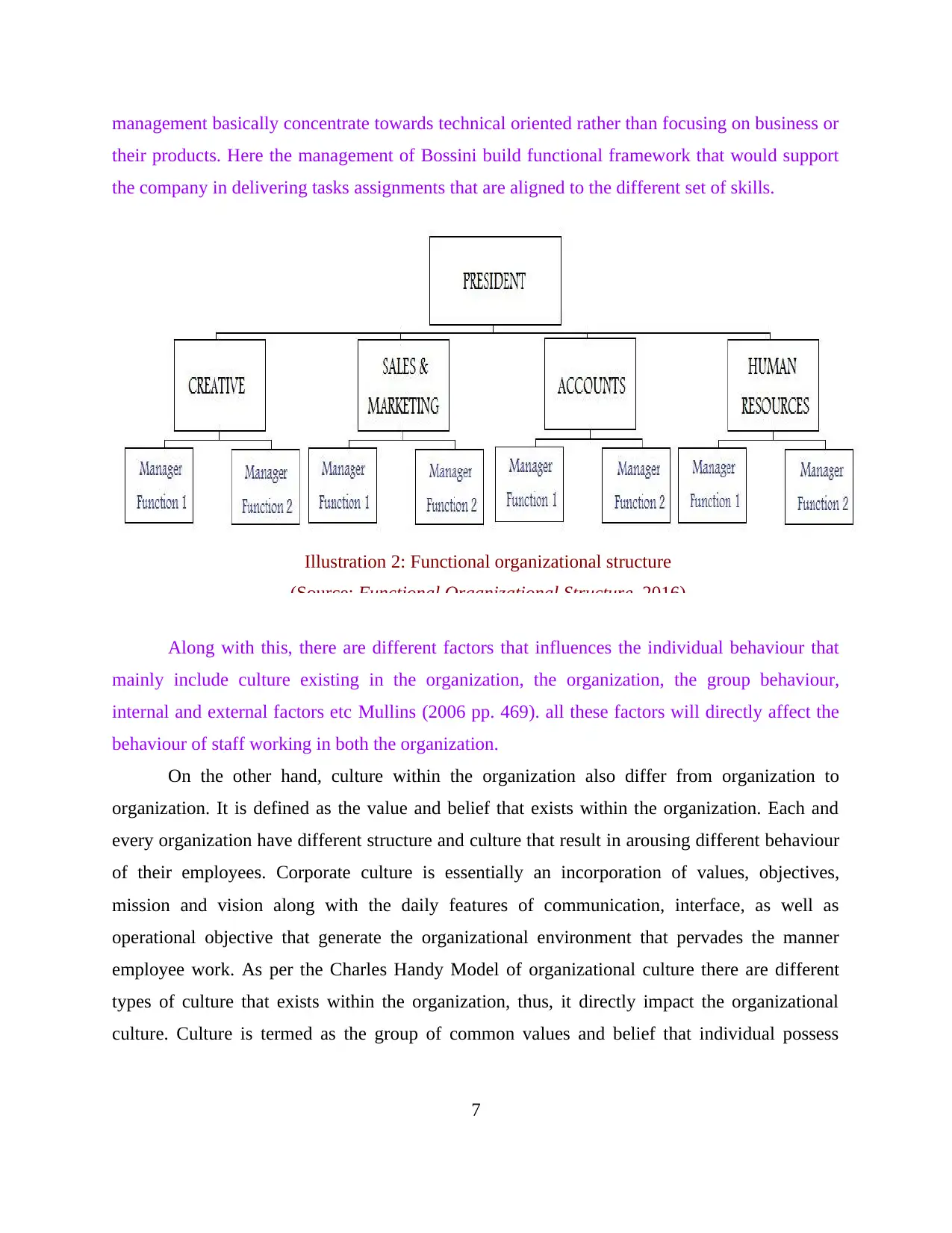
management basically concentrate towards technical oriented rather than focusing on business or
their products. Here the management of Bossini build functional framework that would support
the company in delivering tasks assignments that are aligned to the different set of skills.
Illustration 2: Functional organizational structure
(Source: Functional Organizational Structure, 2016)
Along with this, there are different factors that influences the individual behaviour that
mainly include culture existing in the organization, the organization, the group behaviour,
internal and external factors etc Mullins (2006 pp. 469). all these factors will directly affect the
behaviour of staff working in both the organization.
On the other hand, culture within the organization also differ from organization to
organization. It is defined as the value and belief that exists within the organization. Each and
every organization have different structure and culture that result in arousing different behaviour
of their employees. Corporate culture is essentially an incorporation of values, objectives,
mission and vision along with the daily features of communication, interface, as well as
operational objective that generate the organizational environment that pervades the manner
employee work. As per the Charles Handy Model of organizational culture there are different
types of culture that exists within the organization, thus, it directly impact the organizational
culture. Culture is termed as the group of common values and belief that individual possess
7
their products. Here the management of Bossini build functional framework that would support
the company in delivering tasks assignments that are aligned to the different set of skills.
Illustration 2: Functional organizational structure
(Source: Functional Organizational Structure, 2016)
Along with this, there are different factors that influences the individual behaviour that
mainly include culture existing in the organization, the organization, the group behaviour,
internal and external factors etc Mullins (2006 pp. 469). all these factors will directly affect the
behaviour of staff working in both the organization.
On the other hand, culture within the organization also differ from organization to
organization. It is defined as the value and belief that exists within the organization. Each and
every organization have different structure and culture that result in arousing different behaviour
of their employees. Corporate culture is essentially an incorporation of values, objectives,
mission and vision along with the daily features of communication, interface, as well as
operational objective that generate the organizational environment that pervades the manner
employee work. As per the Charles Handy Model of organizational culture there are different
types of culture that exists within the organization, thus, it directly impact the organizational
culture. Culture is termed as the group of common values and belief that individual possess
7
Paraphrase This Document
Need a fresh take? Get an instant paraphrase of this document with our AI Paraphraser
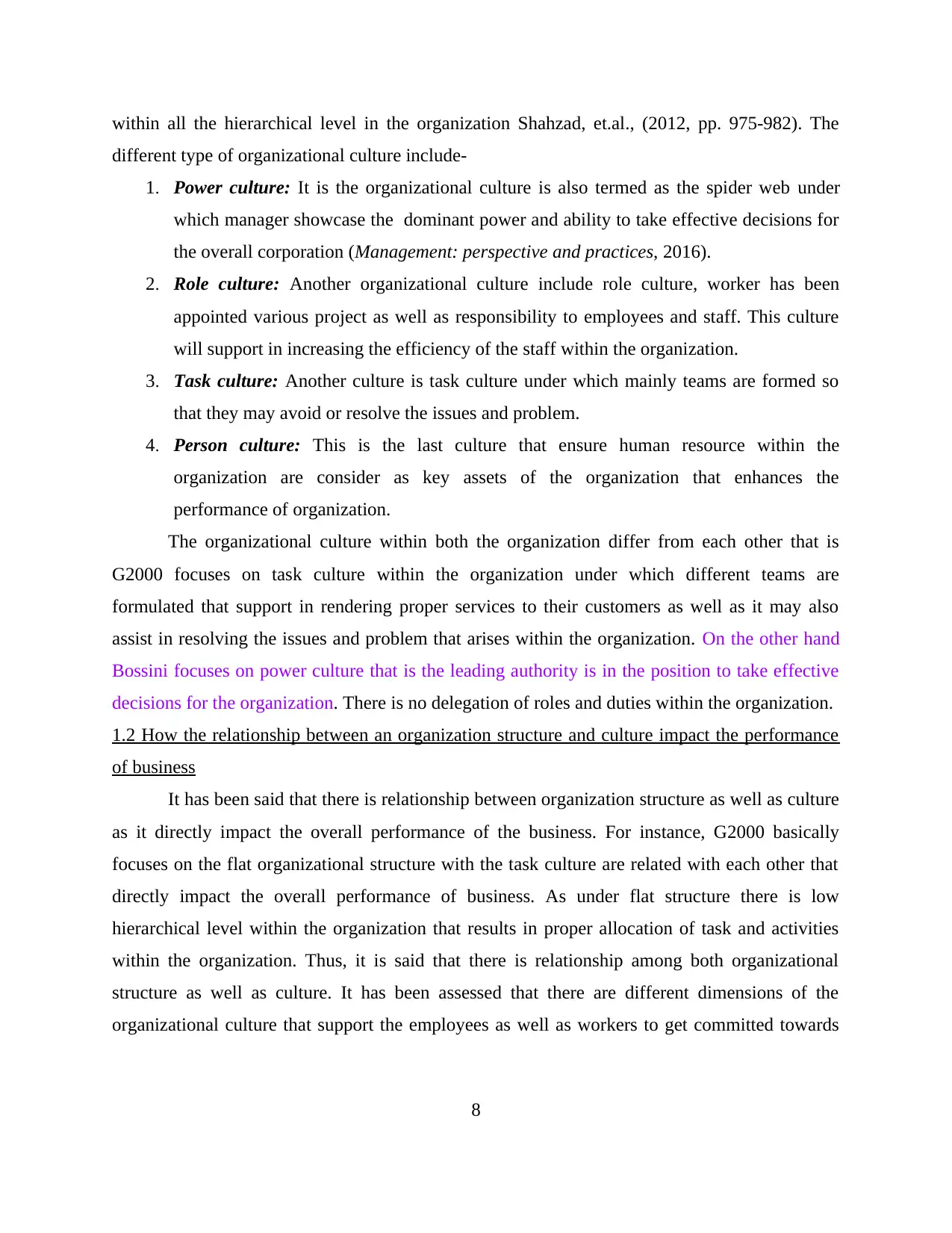
within all the hierarchical level in the organization Shahzad, et.al., (2012, pp. 975-982). The
different type of organizational culture include-
1. Power culture: It is the organizational culture is also termed as the spider web under
which manager showcase the dominant power and ability to take effective decisions for
the overall corporation (Management: perspective and practices, 2016).
2. Role culture: Another organizational culture include role culture, worker has been
appointed various project as well as responsibility to employees and staff. This culture
will support in increasing the efficiency of the staff within the organization.
3. Task culture: Another culture is task culture under which mainly teams are formed so
that they may avoid or resolve the issues and problem.
4. Person culture: This is the last culture that ensure human resource within the
organization are consider as key assets of the organization that enhances the
performance of organization.
The organizational culture within both the organization differ from each other that is
G2000 focuses on task culture within the organization under which different teams are
formulated that support in rendering proper services to their customers as well as it may also
assist in resolving the issues and problem that arises within the organization. On the other hand
Bossini focuses on power culture that is the leading authority is in the position to take effective
decisions for the organization. There is no delegation of roles and duties within the organization.
1.2 How the relationship between an organization structure and culture impact the performance
of business
It has been said that there is relationship between organization structure as well as culture
as it directly impact the overall performance of the business. For instance, G2000 basically
focuses on the flat organizational structure with the task culture are related with each other that
directly impact the overall performance of business. As under flat structure there is low
hierarchical level within the organization that results in proper allocation of task and activities
within the organization. Thus, it is said that there is relationship among both organizational
structure as well as culture. It has been assessed that there are different dimensions of the
organizational culture that support the employees as well as workers to get committed towards
8
different type of organizational culture include-
1. Power culture: It is the organizational culture is also termed as the spider web under
which manager showcase the dominant power and ability to take effective decisions for
the overall corporation (Management: perspective and practices, 2016).
2. Role culture: Another organizational culture include role culture, worker has been
appointed various project as well as responsibility to employees and staff. This culture
will support in increasing the efficiency of the staff within the organization.
3. Task culture: Another culture is task culture under which mainly teams are formed so
that they may avoid or resolve the issues and problem.
4. Person culture: This is the last culture that ensure human resource within the
organization are consider as key assets of the organization that enhances the
performance of organization.
The organizational culture within both the organization differ from each other that is
G2000 focuses on task culture within the organization under which different teams are
formulated that support in rendering proper services to their customers as well as it may also
assist in resolving the issues and problem that arises within the organization. On the other hand
Bossini focuses on power culture that is the leading authority is in the position to take effective
decisions for the organization. There is no delegation of roles and duties within the organization.
1.2 How the relationship between an organization structure and culture impact the performance
of business
It has been said that there is relationship between organization structure as well as culture
as it directly impact the overall performance of the business. For instance, G2000 basically
focuses on the flat organizational structure with the task culture are related with each other that
directly impact the overall performance of business. As under flat structure there is low
hierarchical level within the organization that results in proper allocation of task and activities
within the organization. Thus, it is said that there is relationship among both organizational
structure as well as culture. It has been assessed that there are different dimensions of the
organizational culture that support the employees as well as workers to get committed towards
8
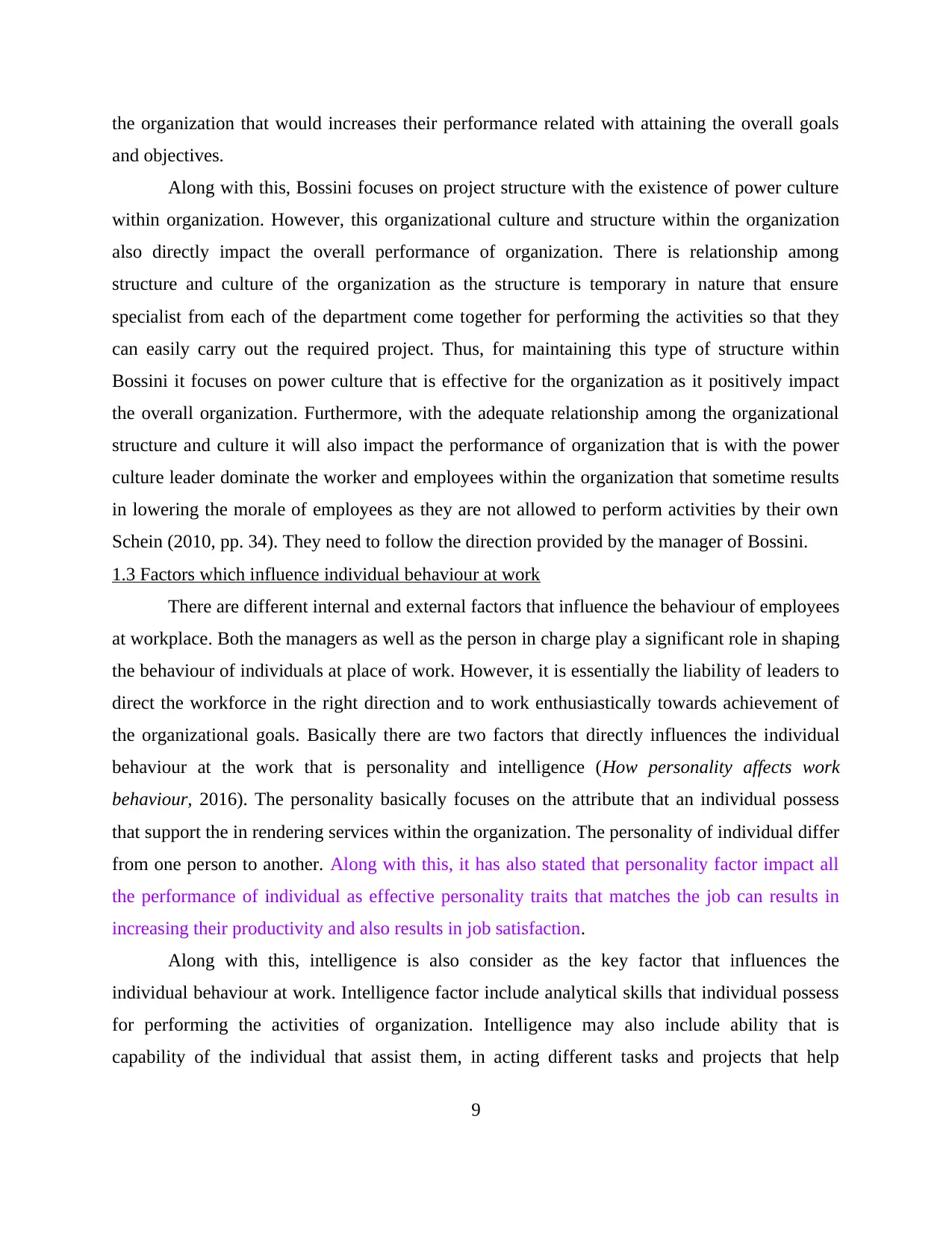
the organization that would increases their performance related with attaining the overall goals
and objectives.
Along with this, Bossini focuses on project structure with the existence of power culture
within organization. However, this organizational culture and structure within the organization
also directly impact the overall performance of organization. There is relationship among
structure and culture of the organization as the structure is temporary in nature that ensure
specialist from each of the department come together for performing the activities so that they
can easily carry out the required project. Thus, for maintaining this type of structure within
Bossini it focuses on power culture that is effective for the organization as it positively impact
the overall organization. Furthermore, with the adequate relationship among the organizational
structure and culture it will also impact the performance of organization that is with the power
culture leader dominate the worker and employees within the organization that sometime results
in lowering the morale of employees as they are not allowed to perform activities by their own
Schein (2010, pp. 34). They need to follow the direction provided by the manager of Bossini.
1.3 Factors which influence individual behaviour at work
There are different internal and external factors that influence the behaviour of employees
at workplace. Both the managers as well as the person in charge play a significant role in shaping
the behaviour of individuals at place of work. However, it is essentially the liability of leaders to
direct the workforce in the right direction and to work enthusiastically towards achievement of
the organizational goals. Basically there are two factors that directly influences the individual
behaviour at the work that is personality and intelligence (How personality affects work
behaviour, 2016). The personality basically focuses on the attribute that an individual possess
that support the in rendering services within the organization. The personality of individual differ
from one person to another. Along with this, it has also stated that personality factor impact all
the performance of individual as effective personality traits that matches the job can results in
increasing their productivity and also results in job satisfaction.
Along with this, intelligence is also consider as the key factor that influences the
individual behaviour at work. Intelligence factor include analytical skills that individual possess
for performing the activities of organization. Intelligence may also include ability that is
capability of the individual that assist them, in acting different tasks and projects that help
9
and objectives.
Along with this, Bossini focuses on project structure with the existence of power culture
within organization. However, this organizational culture and structure within the organization
also directly impact the overall performance of organization. There is relationship among
structure and culture of the organization as the structure is temporary in nature that ensure
specialist from each of the department come together for performing the activities so that they
can easily carry out the required project. Thus, for maintaining this type of structure within
Bossini it focuses on power culture that is effective for the organization as it positively impact
the overall organization. Furthermore, with the adequate relationship among the organizational
structure and culture it will also impact the performance of organization that is with the power
culture leader dominate the worker and employees within the organization that sometime results
in lowering the morale of employees as they are not allowed to perform activities by their own
Schein (2010, pp. 34). They need to follow the direction provided by the manager of Bossini.
1.3 Factors which influence individual behaviour at work
There are different internal and external factors that influence the behaviour of employees
at workplace. Both the managers as well as the person in charge play a significant role in shaping
the behaviour of individuals at place of work. However, it is essentially the liability of leaders to
direct the workforce in the right direction and to work enthusiastically towards achievement of
the organizational goals. Basically there are two factors that directly influences the individual
behaviour at the work that is personality and intelligence (How personality affects work
behaviour, 2016). The personality basically focuses on the attribute that an individual possess
that support the in rendering services within the organization. The personality of individual differ
from one person to another. Along with this, it has also stated that personality factor impact all
the performance of individual as effective personality traits that matches the job can results in
increasing their productivity and also results in job satisfaction.
Along with this, intelligence is also consider as the key factor that influences the
individual behaviour at work. Intelligence factor include analytical skills that individual possess
for performing the activities of organization. Intelligence may also include ability that is
capability of the individual that assist them, in acting different tasks and projects that help
9
⊘ This is a preview!⊘
Do you want full access?
Subscribe today to unlock all pages.

Trusted by 1+ million students worldwide
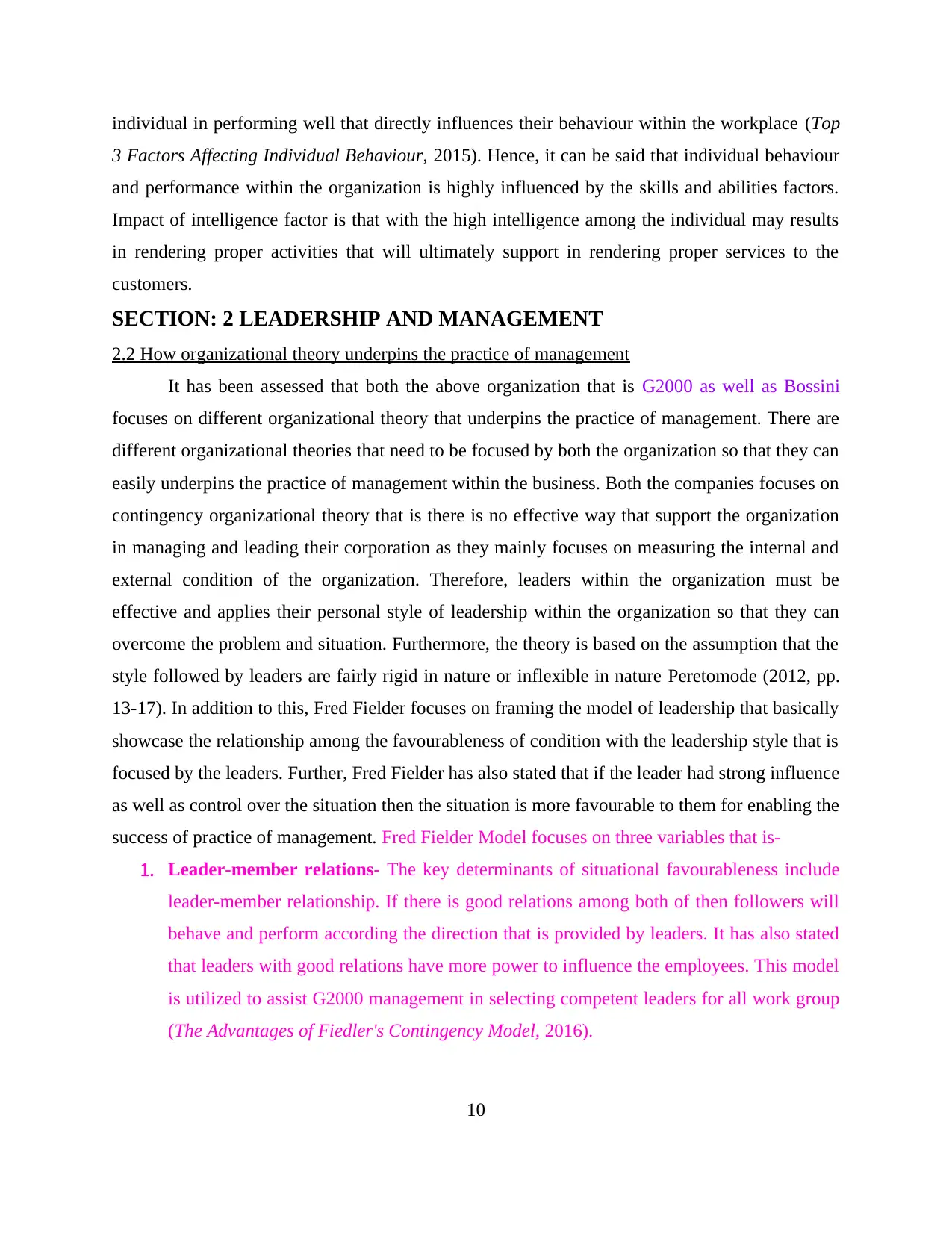
individual in performing well that directly influences their behaviour within the workplace (Top
3 Factors Affecting Individual Behaviour, 2015). Hence, it can be said that individual behaviour
and performance within the organization is highly influenced by the skills and abilities factors.
Impact of intelligence factor is that with the high intelligence among the individual may results
in rendering proper activities that will ultimately support in rendering proper services to the
customers.
SECTION: 2 LEADERSHIP AND MANAGEMENT
2.2 How organizational theory underpins the practice of management
It has been assessed that both the above organization that is G2000 as well as Bossini
focuses on different organizational theory that underpins the practice of management. There are
different organizational theories that need to be focused by both the organization so that they can
easily underpins the practice of management within the business. Both the companies focuses on
contingency organizational theory that is there is no effective way that support the organization
in managing and leading their corporation as they mainly focuses on measuring the internal and
external condition of the organization. Therefore, leaders within the organization must be
effective and applies their personal style of leadership within the organization so that they can
overcome the problem and situation. Furthermore, the theory is based on the assumption that the
style followed by leaders are fairly rigid in nature or inflexible in nature Peretomode (2012, pp.
13-17). In addition to this, Fred Fielder focuses on framing the model of leadership that basically
showcase the relationship among the favourableness of condition with the leadership style that is
focused by the leaders. Further, Fred Fielder has also stated that if the leader had strong influence
as well as control over the situation then the situation is more favourable to them for enabling the
success of practice of management. Fred Fielder Model focuses on three variables that is-
1. Leader-member relations- The key determinants of situational favourableness include
leader-member relationship. If there is good relations among both of then followers will
behave and perform according the direction that is provided by leaders. It has also stated
that leaders with good relations have more power to influence the employees. This model
is utilized to assist G2000 management in selecting competent leaders for all work group
(The Advantages of Fiedler's Contingency Model, 2016).
10
3 Factors Affecting Individual Behaviour, 2015). Hence, it can be said that individual behaviour
and performance within the organization is highly influenced by the skills and abilities factors.
Impact of intelligence factor is that with the high intelligence among the individual may results
in rendering proper activities that will ultimately support in rendering proper services to the
customers.
SECTION: 2 LEADERSHIP AND MANAGEMENT
2.2 How organizational theory underpins the practice of management
It has been assessed that both the above organization that is G2000 as well as Bossini
focuses on different organizational theory that underpins the practice of management. There are
different organizational theories that need to be focused by both the organization so that they can
easily underpins the practice of management within the business. Both the companies focuses on
contingency organizational theory that is there is no effective way that support the organization
in managing and leading their corporation as they mainly focuses on measuring the internal and
external condition of the organization. Therefore, leaders within the organization must be
effective and applies their personal style of leadership within the organization so that they can
overcome the problem and situation. Furthermore, the theory is based on the assumption that the
style followed by leaders are fairly rigid in nature or inflexible in nature Peretomode (2012, pp.
13-17). In addition to this, Fred Fielder focuses on framing the model of leadership that basically
showcase the relationship among the favourableness of condition with the leadership style that is
focused by the leaders. Further, Fred Fielder has also stated that if the leader had strong influence
as well as control over the situation then the situation is more favourable to them for enabling the
success of practice of management. Fred Fielder Model focuses on three variables that is-
1. Leader-member relations- The key determinants of situational favourableness include
leader-member relationship. If there is good relations among both of then followers will
behave and perform according the direction that is provided by leaders. It has also stated
that leaders with good relations have more power to influence the employees. This model
is utilized to assist G2000 management in selecting competent leaders for all work group
(The Advantages of Fiedler's Contingency Model, 2016).
10
Paraphrase This Document
Need a fresh take? Get an instant paraphrase of this document with our AI Paraphraser
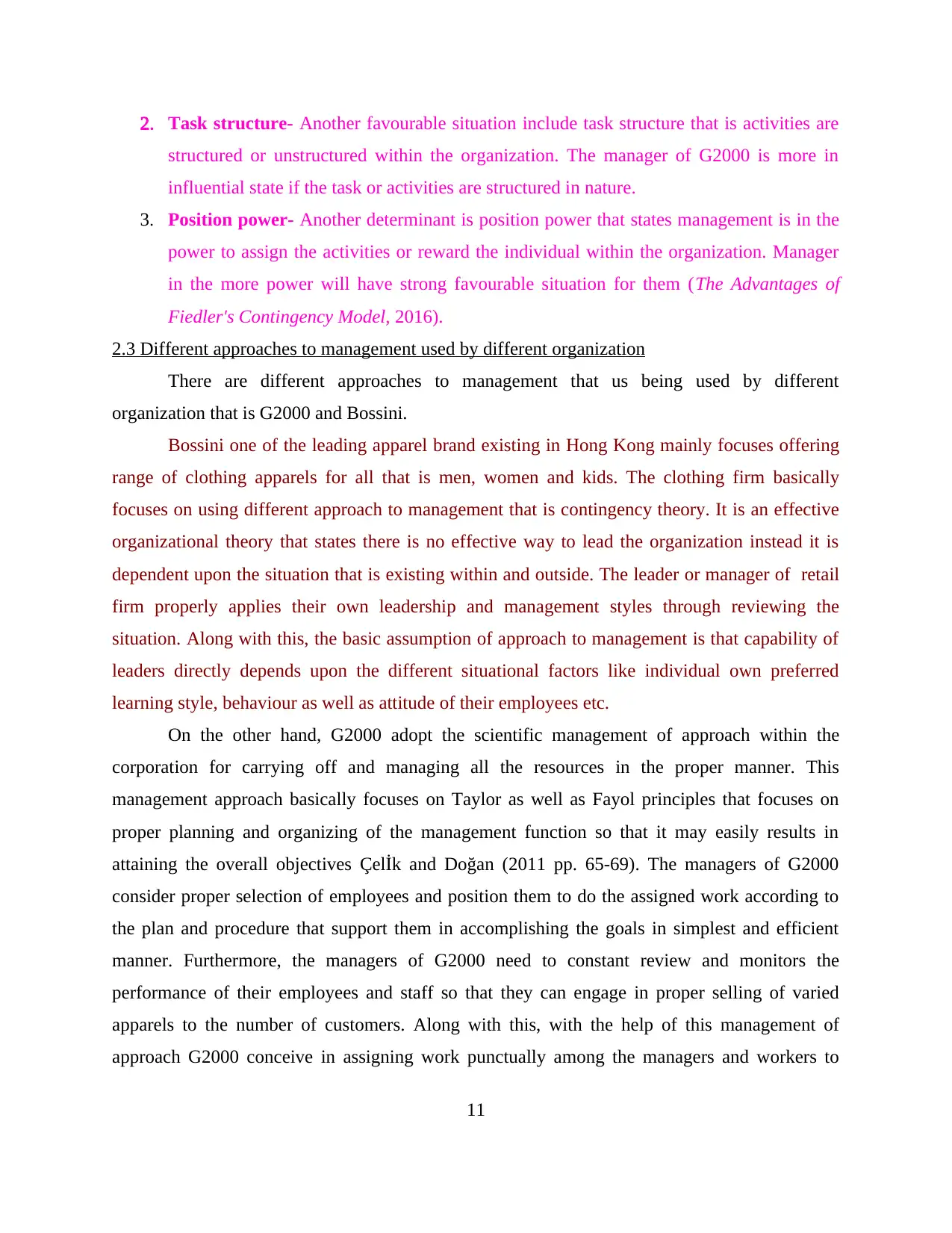
2. Task structure- Another favourable situation include task structure that is activities are
structured or unstructured within the organization. The manager of G2000 is more in
influential state if the task or activities are structured in nature.
3. Position power- Another determinant is position power that states management is in the
power to assign the activities or reward the individual within the organization. Manager
in the more power will have strong favourable situation for them (The Advantages of
Fiedler's Contingency Model, 2016).
2.3 Different approaches to management used by different organization
There are different approaches to management that us being used by different
organization that is G2000 and Bossini.
Bossini one of the leading apparel brand existing in Hong Kong mainly focuses offering
range of clothing apparels for all that is men, women and kids. The clothing firm basically
focuses on using different approach to management that is contingency theory. It is an effective
organizational theory that states there is no effective way to lead the organization instead it is
dependent upon the situation that is existing within and outside. The leader or manager of retail
firm properly applies their own leadership and management styles through reviewing the
situation. Along with this, the basic assumption of approach to management is that capability of
leaders directly depends upon the different situational factors like individual own preferred
learning style, behaviour as well as attitude of their employees etc.
On the other hand, G2000 adopt the scientific management of approach within the
corporation for carrying off and managing all the resources in the proper manner. This
management approach basically focuses on Taylor as well as Fayol principles that focuses on
proper planning and organizing of the management function so that it may easily results in
attaining the overall objectives Çelİk and Doğan (2011 pp. 65-69). The managers of G2000
consider proper selection of employees and position them to do the assigned work according to
the plan and procedure that support them in accomplishing the goals in simplest and efficient
manner. Furthermore, the managers of G2000 need to constant review and monitors the
performance of their employees and staff so that they can engage in proper selling of varied
apparels to the number of customers. Along with this, with the help of this management of
approach G2000 conceive in assigning work punctually among the managers and workers to
11
structured or unstructured within the organization. The manager of G2000 is more in
influential state if the task or activities are structured in nature.
3. Position power- Another determinant is position power that states management is in the
power to assign the activities or reward the individual within the organization. Manager
in the more power will have strong favourable situation for them (The Advantages of
Fiedler's Contingency Model, 2016).
2.3 Different approaches to management used by different organization
There are different approaches to management that us being used by different
organization that is G2000 and Bossini.
Bossini one of the leading apparel brand existing in Hong Kong mainly focuses offering
range of clothing apparels for all that is men, women and kids. The clothing firm basically
focuses on using different approach to management that is contingency theory. It is an effective
organizational theory that states there is no effective way to lead the organization instead it is
dependent upon the situation that is existing within and outside. The leader or manager of retail
firm properly applies their own leadership and management styles through reviewing the
situation. Along with this, the basic assumption of approach to management is that capability of
leaders directly depends upon the different situational factors like individual own preferred
learning style, behaviour as well as attitude of their employees etc.
On the other hand, G2000 adopt the scientific management of approach within the
corporation for carrying off and managing all the resources in the proper manner. This
management approach basically focuses on Taylor as well as Fayol principles that focuses on
proper planning and organizing of the management function so that it may easily results in
attaining the overall objectives Çelİk and Doğan (2011 pp. 65-69). The managers of G2000
consider proper selection of employees and position them to do the assigned work according to
the plan and procedure that support them in accomplishing the goals in simplest and efficient
manner. Furthermore, the managers of G2000 need to constant review and monitors the
performance of their employees and staff so that they can engage in proper selling of varied
apparels to the number of customers. Along with this, with the help of this management of
approach G2000 conceive in assigning work punctually among the managers and workers to
11
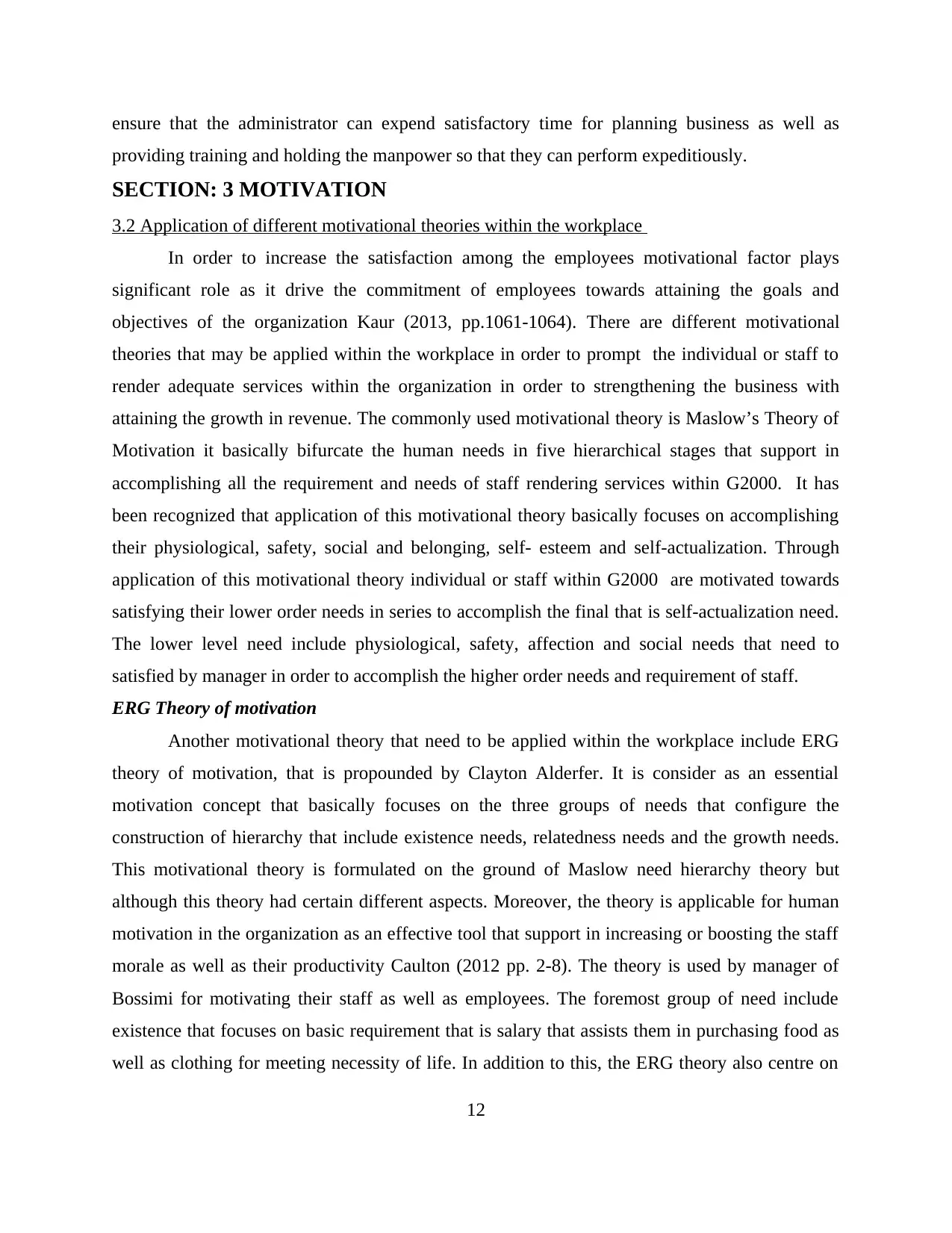
ensure that the administrator can expend satisfactory time for planning business as well as
providing training and holding the manpower so that they can perform expeditiously.
SECTION: 3 MOTIVATION
3.2 Application of different motivational theories within the workplace
In order to increase the satisfaction among the employees motivational factor plays
significant role as it drive the commitment of employees towards attaining the goals and
objectives of the organization Kaur (2013, pp.1061-1064). There are different motivational
theories that may be applied within the workplace in order to prompt the individual or staff to
render adequate services within the organization in order to strengthening the business with
attaining the growth in revenue. The commonly used motivational theory is Maslow’s Theory of
Motivation it basically bifurcate the human needs in five hierarchical stages that support in
accomplishing all the requirement and needs of staff rendering services within G2000. It has
been recognized that application of this motivational theory basically focuses on accomplishing
their physiological, safety, social and belonging, self- esteem and self-actualization. Through
application of this motivational theory individual or staff within G2000 are motivated towards
satisfying their lower order needs in series to accomplish the final that is self-actualization need.
The lower level need include physiological, safety, affection and social needs that need to
satisfied by manager in order to accomplish the higher order needs and requirement of staff.
ERG Theory of motivation
Another motivational theory that need to be applied within the workplace include ERG
theory of motivation, that is propounded by Clayton Alderfer. It is consider as an essential
motivation concept that basically focuses on the three groups of needs that configure the
construction of hierarchy that include existence needs, relatedness needs and the growth needs.
This motivational theory is formulated on the ground of Maslow need hierarchy theory but
although this theory had certain different aspects. Moreover, the theory is applicable for human
motivation in the organization as an effective tool that support in increasing or boosting the staff
morale as well as their productivity Caulton (2012 pp. 2-8). The theory is used by manager of
Bossimi for motivating their staff as well as employees. The foremost group of need include
existence that focuses on basic requirement that is salary that assists them in purchasing food as
well as clothing for meeting necessity of life. In addition to this, the ERG theory also centre on
12
providing training and holding the manpower so that they can perform expeditiously.
SECTION: 3 MOTIVATION
3.2 Application of different motivational theories within the workplace
In order to increase the satisfaction among the employees motivational factor plays
significant role as it drive the commitment of employees towards attaining the goals and
objectives of the organization Kaur (2013, pp.1061-1064). There are different motivational
theories that may be applied within the workplace in order to prompt the individual or staff to
render adequate services within the organization in order to strengthening the business with
attaining the growth in revenue. The commonly used motivational theory is Maslow’s Theory of
Motivation it basically bifurcate the human needs in five hierarchical stages that support in
accomplishing all the requirement and needs of staff rendering services within G2000. It has
been recognized that application of this motivational theory basically focuses on accomplishing
their physiological, safety, social and belonging, self- esteem and self-actualization. Through
application of this motivational theory individual or staff within G2000 are motivated towards
satisfying their lower order needs in series to accomplish the final that is self-actualization need.
The lower level need include physiological, safety, affection and social needs that need to
satisfied by manager in order to accomplish the higher order needs and requirement of staff.
ERG Theory of motivation
Another motivational theory that need to be applied within the workplace include ERG
theory of motivation, that is propounded by Clayton Alderfer. It is consider as an essential
motivation concept that basically focuses on the three groups of needs that configure the
construction of hierarchy that include existence needs, relatedness needs and the growth needs.
This motivational theory is formulated on the ground of Maslow need hierarchy theory but
although this theory had certain different aspects. Moreover, the theory is applicable for human
motivation in the organization as an effective tool that support in increasing or boosting the staff
morale as well as their productivity Caulton (2012 pp. 2-8). The theory is used by manager of
Bossimi for motivating their staff as well as employees. The foremost group of need include
existence that focuses on basic requirement that is salary that assists them in purchasing food as
well as clothing for meeting necessity of life. In addition to this, the ERG theory also centre on
12
⊘ This is a preview!⊘
Do you want full access?
Subscribe today to unlock all pages.

Trusted by 1+ million students worldwide
1 out of 20
Related Documents
Your All-in-One AI-Powered Toolkit for Academic Success.
+13062052269
info@desklib.com
Available 24*7 on WhatsApp / Email
![[object Object]](/_next/static/media/star-bottom.7253800d.svg)
Unlock your academic potential
Copyright © 2020–2025 A2Z Services. All Rights Reserved. Developed and managed by ZUCOL.





